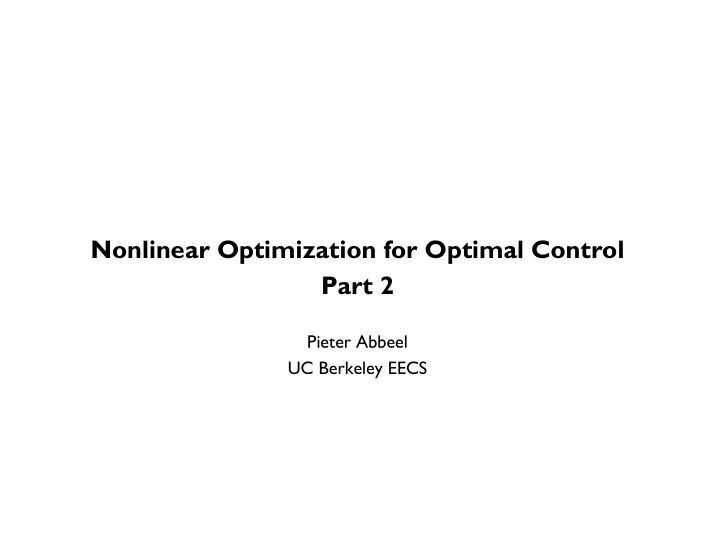

Nonlinear Optimization for Optimal Control Part 2 Pieter Abbeel UC Berkeley EECS
Outline n From linear to nonlinear n Model-predictive control (MPC)
From Linear to Nonlinear We know how to solve (assuming g t , U t , X t convex): n (1) How about nonlinear dynamics: n Shooting Methods (feasible) Collocation Methods (infeasible) Iterate for i=1, 2, 3, … Iterate for i=1, 2, 3, … Execute --- (no execution)--- (from solving (1)) Linearize around resulting trajectory Linearize around current solution of (1) Solve (1) for current linearization Solve (1) for current linearization Sequential Quadratic Programming (SQP) = either of the above methods, but also means you approximate objective function with convex quadratic
Example Shooting
Example Collocation
Practical Benefits and Issues with Shooting + At all times the sequence of controls is meaningful, and the objective function optimized directly corresponds to the current control sequence - For unstable systems, need to run feedback controller during forward simulation n Why? Open loop sequence of control inputs computed for the linearized system will not be perfect for the nonlinear system. If the nonlinear system is unstable, open loop execution would give poor performance. n Fixes: n Run Model Predictive Control for forward simulation n Compute a linear feedback controller from the 2 nd order Taylor expansion at the optimum (exercise: work out the details!)
Practical Benefits and Issues with Collocation + Can initialize with infeasible trajectory. Hence if you have a rough idea of a sequence of states that would form a reasonable solution, you can initialize with this sequence of states without needing to know a control sequence that would lead through them, and without needing to make them consistent with the dynamics - Sequence of control inputs and states might never converge onto a feasible sequence
Iterative LQR versus Sequential Convex Programming Both can solve n Can run iterative LQR both as a shooting method or as a collocation method, it’s just a n different way of executing “Solve (1) for current linearization.” In case of shooting, the sequence of linear feedback controllers found can be used for (closed-loop) execution. Iterative LQR might need some outer iterations, adjusting “t” of the log barrier n Shooting Methods (feasible) Collocation Methods (infeasible) Iterate for i=1, 2, 3, … Iterate for i=1, 2, 3, … Execute feedback controller (from solving (1)) --- (no execution)--- Linearize around resulting trajectory Linearize around current solution of (1) Solve (1) for current linearization Solve (1) for current linearization Sequential Quadratic Programming (SQP) = either of the above methods, but instead of using linearization, linearize equality constraints, convex-quadratic approximate objective function
Outline n From linear to nonlinear n Model-predictive control (MPC) For an entire semester course on MPC: Francesco Borrelli
Model Predictive Control n Given: n For k=0, 1, 2, …, T n Solve n Execute u k n Observe resulting state,
Initialization n Initialization with solution from iteration k-1 can make solver very fast n can be done most conveniently with infeasible start Newton method
Terminal Cost n Re-solving over full horizon can be computationally too expensive given frequency at which one might want to do control n Instead solve Estimate of cost-to-go n Estimate of cost-to-go n If using iterative LQR can use quadratic value function found for time t+H n If using nonlinear optimization for open-loop control sequence à can find quadratic approximation from Hessian at solution (exercise, try to derive it!)
Car Control with MPC Video n Prof. Francesco Borrelli (M.E.) and collaborators n http://video.google.com/videoplay? docid=-8338487882440308275
Recommend
More recommend